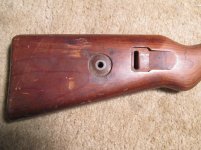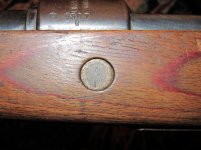DiehardWWII
Well-known member
Hello,
For your viewing and comment here is a Luftwaffe depot build rifle marked with the Luftamp 4 proof and found in the e-block serial range as is supposedly common with these. It uses a 1918 recycled DWM reciever which I also read may be common at the end of the depot build range. I just bought it today from a friend. I told him what it was when I first saw it and thus offered a fair price. I was fairly certain it was correct and seems to match the profile since doing even more research. I am not sure why the rifles were in such short supply in '40-'41 (I think this is the accepted period - please correct me) that they needed to fulfill the contract using rebuilds but I am sure someone here will know. Please post any commentary, positive or negative, and please understand that while I understand enough to know what it is, I can still learn plenty more so any info is welcome. I also assume these were primarily issues to paratroops and AA gunners, correct me if I am wrong.
Thanks,
Diehard
For your viewing and comment here is a Luftwaffe depot build rifle marked with the Luftamp 4 proof and found in the e-block serial range as is supposedly common with these. It uses a 1918 recycled DWM reciever which I also read may be common at the end of the depot build range. I just bought it today from a friend. I told him what it was when I first saw it and thus offered a fair price. I was fairly certain it was correct and seems to match the profile since doing even more research. I am not sure why the rifles were in such short supply in '40-'41 (I think this is the accepted period - please correct me) that they needed to fulfill the contract using rebuilds but I am sure someone here will know. Please post any commentary, positive or negative, and please understand that while I understand enough to know what it is, I can still learn plenty more so any info is welcome. I also assume these were primarily issues to paratroops and AA gunners, correct me if I am wrong.
Thanks,
Diehard
Attachments
-
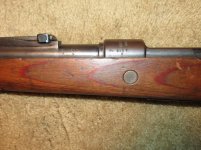 IMG_2120.jpg261.1 KB · Views: 124
IMG_2120.jpg261.1 KB · Views: 124 -
 IMG_2119.jpg247.6 KB · Views: 145
IMG_2119.jpg247.6 KB · Views: 145 -
 IMG_2117.jpg226.2 KB · Views: 131
IMG_2117.jpg226.2 KB · Views: 131 -
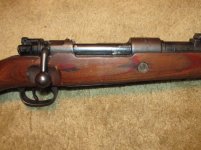 IMG_2115.jpg221.9 KB · Views: 100
IMG_2115.jpg221.9 KB · Views: 100 -
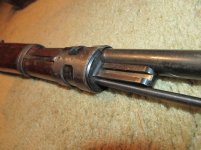 IMG_2114.jpg234.4 KB · Views: 98
IMG_2114.jpg234.4 KB · Views: 98 -
 IMG_2113.jpg231.1 KB · Views: 95
IMG_2113.jpg231.1 KB · Views: 95 -
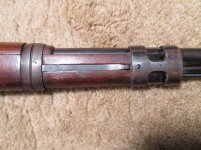 IMG_2109.jpg248.8 KB · Views: 88
IMG_2109.jpg248.8 KB · Views: 88 -
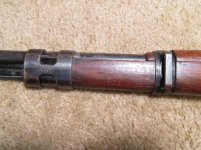 IMG_2107.jpg267.5 KB · Views: 86
IMG_2107.jpg267.5 KB · Views: 86 -
 IMG_2121.jpg207.1 KB · Views: 88
IMG_2121.jpg207.1 KB · Views: 88 -
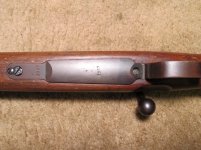 IMG_2105.jpg218.1 KB · Views: 94
IMG_2105.jpg218.1 KB · Views: 94







